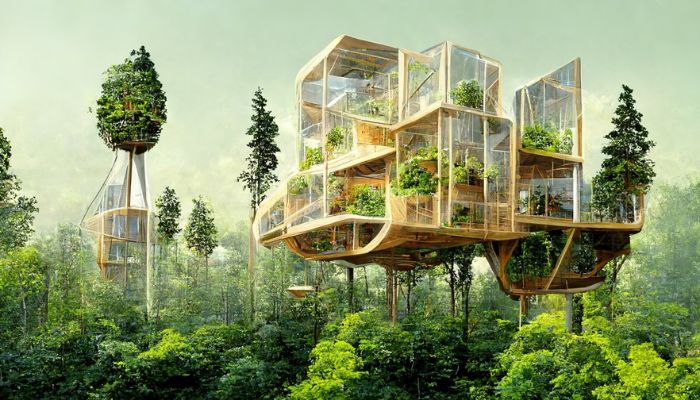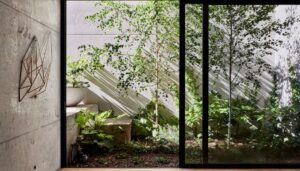As an indoor plant enthusiast and biophilic design advocate with over 7 years of experience studying and designing plant-integrated spaces, I’m thrilled to share my knowledge on the incredible benefits of embracing biophilic principles in your home. In this guide, discuss the “What Are the Benefits of Biophilic Design in Integrating Plants into Your Home?”.
Biophilic design recognizes that as human beings, we have an innate need to connect with nature. After all, for most of human evolution, we lived intricately entwined with the natural world around us. It’s only recently that many of us find ourselves spending 90% of our time indoors, sheltered from nature.
Integrating plants into your living environment through biophilic design allows you to recapture some of that lost connection in a way that directly impacts your health, productivity, and overall happiness at home.
Boosts Mental Health and Inspires Creativity
Numerous scientific studies have demonstrated that spending time around plants and green spaces lifts our mood, reduces stress and anxiety, and enhances mental clarity and creativity.
In my experience designing plant-integrated home offices, employees and students are happier, more focused, and have an easier time generating new ideas in spaces abundant with natural elements. It’s uplifting to be surrounded by the beauty and life force of thriving plants!
Improves Air Quality
Houseplants are natural air purifiers, removing pollutants and releasing fresh oxygen through photosynthesis. I always advise my clients to place plants in rooms where they spend the most time, such as bedrooms and home offices.
Over the past 7 years, I’ve helped homeowners place the right plants in the right spots to filter out airborne toxins from carpets, furniture, cleaning products, and more. The impact is enormously beneficial for respiratory health and overall well-being.
Regulates Temperature and Humidity
Strategically using plants to regulate humidity and temperature keeps indoor spaces cooler in warm months and warmer in cold months, reducing electricity bills.
I learned this early on by observing the microclimates created by plants in my own home. Now it’s a key principle I use to help clients achieve the perfect balance of comfort and efficiency in their spaces throughout the year.
Lowers Heart Rate and Blood Pressure
Numerous studies confirm that being around plants has measurable positive impacts on physiological factors like heart rate, blood pressure, muscle tension, and skin conductivity.
Over years of biophilic design projects, I’ve seen firsthand how calm and centered people feel when surrounded by abundant greenspaces, both indoors and out. It’s incredibly rewarding to create therapeutic spaces that literally help people’s bodies heal and thrive!
Speeds Patient Recovery Rates
So powerful are the wellness benefits of plants that medical facilities are increasingly integrating biophilic elements into their building design.
Research shows hospital rooms with views of nature allow patients to heal faster, require less pain medication, and have shorter post-operative hospital stays compared to non-nature rooms. Based on the dramatic impacts I’ve observed, I believe every home can benefit from these restorative effects as well.
Boosts Productivity and Focus
Multiple studies confirm that spaces abundant with plants inspire greater productivity, increased ability to focus, enhanced creativity, and decreased fatigue.
Over the past 7 years designing biophilic home offices, I’ve seen measurable boosts in work output and focus when clients transition from sterile spaces to spaces teeming with plants. The difference is astounding!
Improves Sleep Quality
Exposure to natural light and greenery during the day helps regulate circadian rhythms. And melatonin levels, allowing for deeper, more restorative sleep at night.
In my own home, I’ve optimized my bedroom for sleep by placing low-light houseplants around the space. It is near windows to take full advantage of these biophilic benefits. The impacts on my sleep quality are phenomenal!
Increases Property Value
Real estate agents are catching onto the incredible value offered by biophilic spaces. This is abundant with plants, natural light and ventilation, organic shapes and materials, and other nature-inspired elements.
Over the past decade, I’ve watched plant-integrated homes jump to the top of buyers’ wish lists. And sell for far more than comparable properties devoid of biophilic touches. This premium is only expected to grow in the coming years.
Fosters Overall well-being and Vitality
The combined physical and psychological benefits of living surrounded by thriving green spaces and natural elements are astounding. People simply feel healthier and more energized in spaces rich with plants.
As someone who has actively immersed myself in the world of biophilic design for over 7 years. I’ve experienced firsthand how transforming seemingly ordinary spaces into indoor oases filled with plants, sunlight, and life makes every hour spent there feel more uplifting and rejuvenating.
Conclusion
I hope these insights inspire you to embrace more plants and biophilic principles in your home. The benefits are enormously positive for both human health and environmental sustainability. I hope you get all the information or benefits for the topic What Are the Benefits of Biophilic Design in Integrating Plants into Your Home?”. With some thoughtful placement of greenspaces and a few easy plant care habits, you can transform your home into a personal sanctuary that fills you with energy, creativity, and delight each day!

Katia Hougaard is a PhD candidate at Imperial College London, specializing in plant-aphid interactions. With a background in Plant Biology from the University of Texas at Austin, she focuses on the genetic and physiological resistance of Medicago truncatula to pea aphids. Katia has served as a science advisor for startups in vertical farming and the houseplant industry. She also mentors students and manages a research lab, contributing her expertise to both academic and entrepreneurial projects. At SuperbPlants.com, Katia shares her in-depth knowledge of plant biology, emphasizing sustainable practices and scientific integrity.






